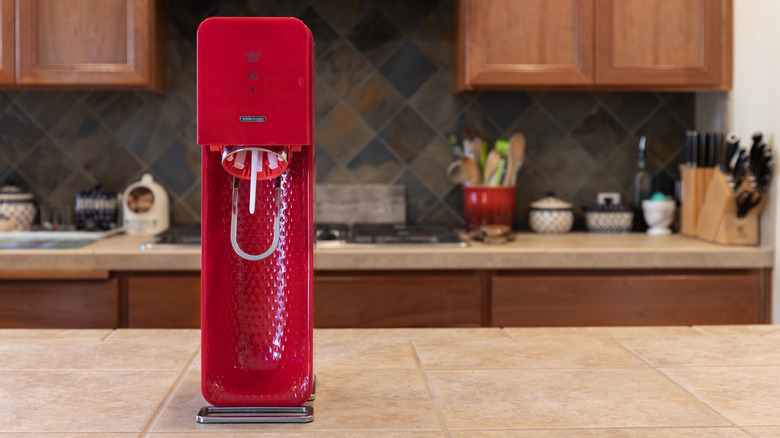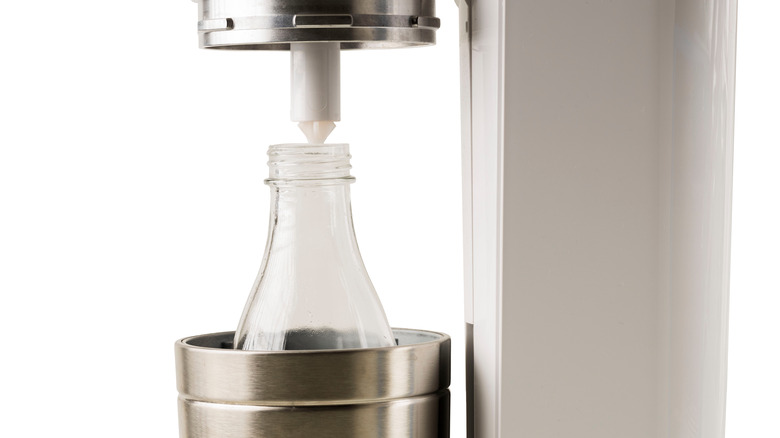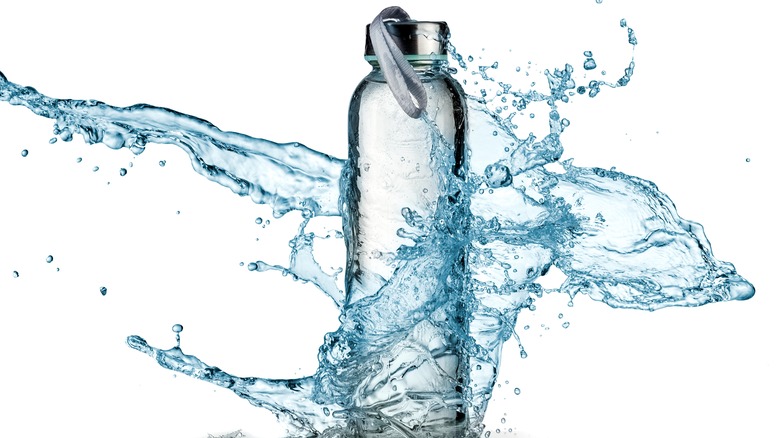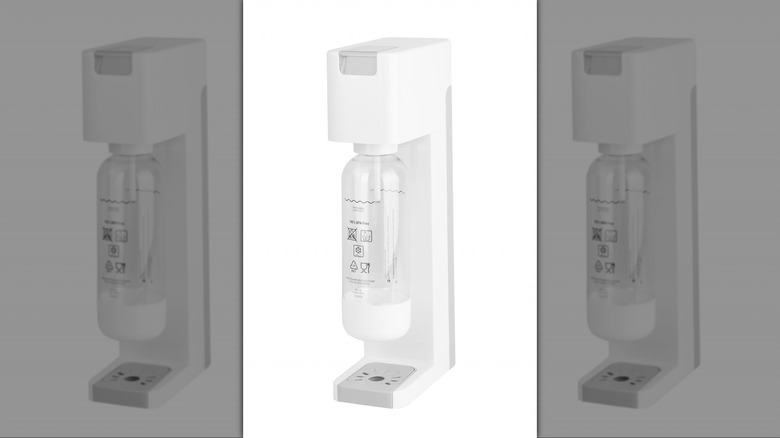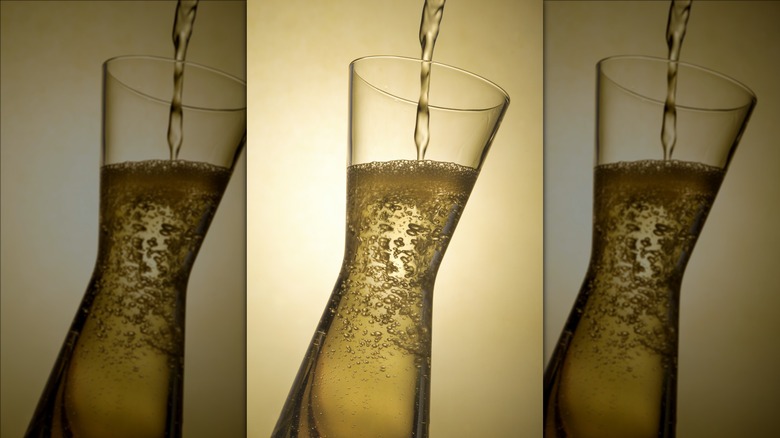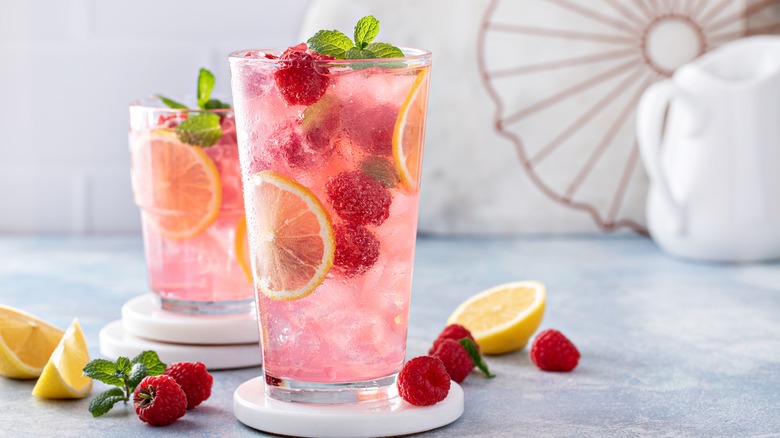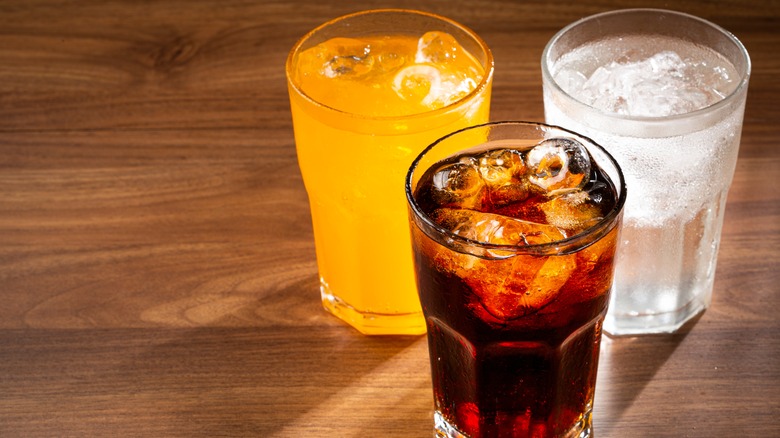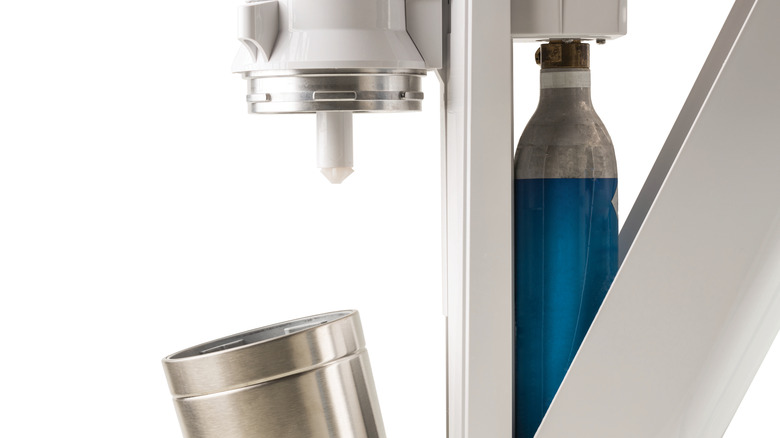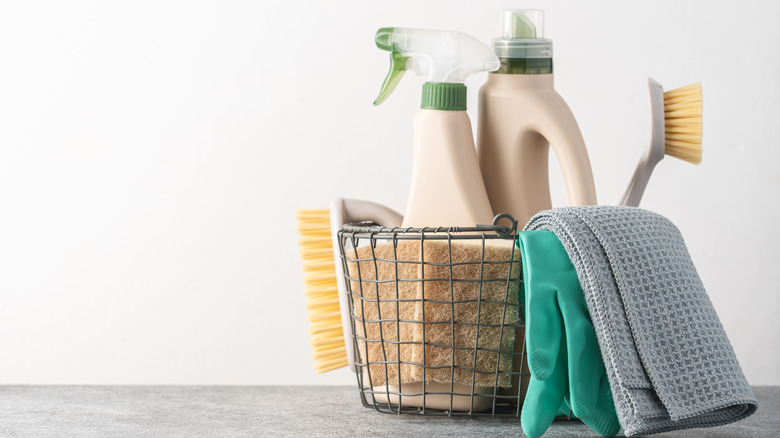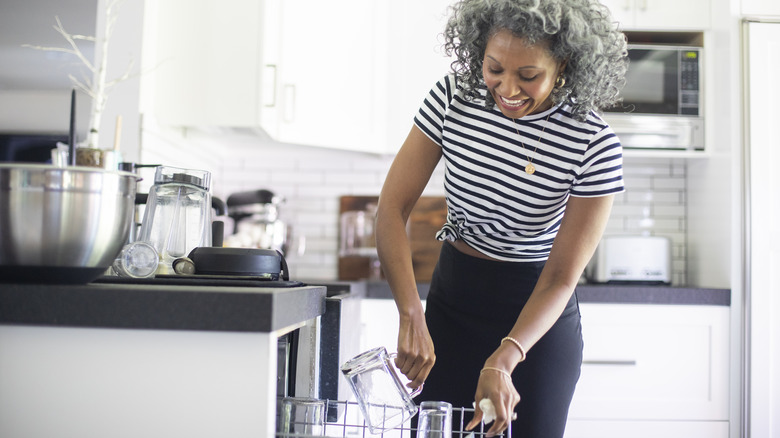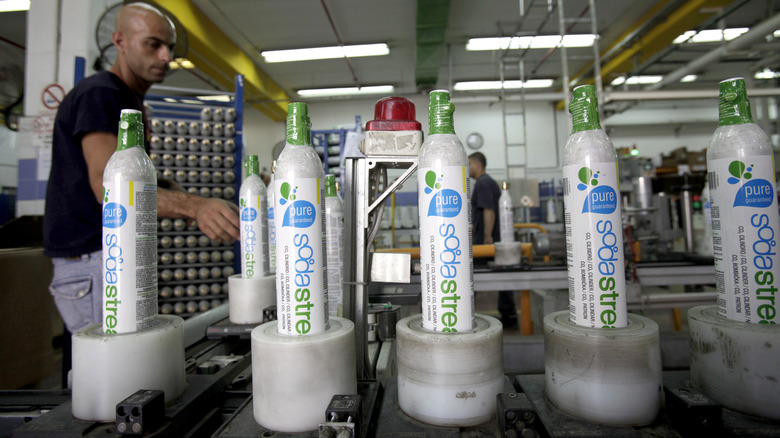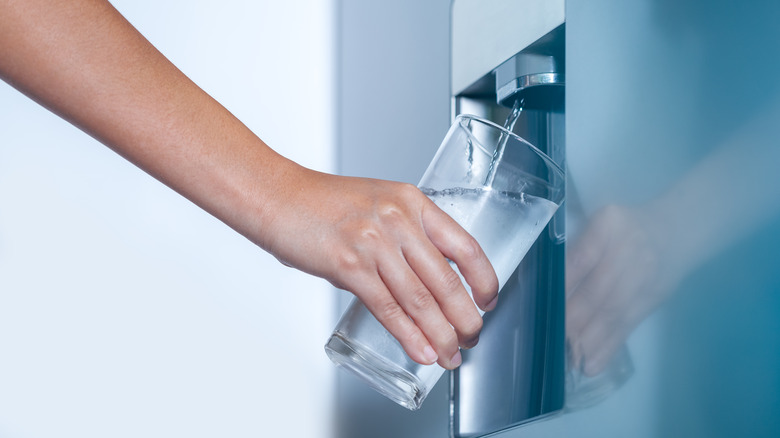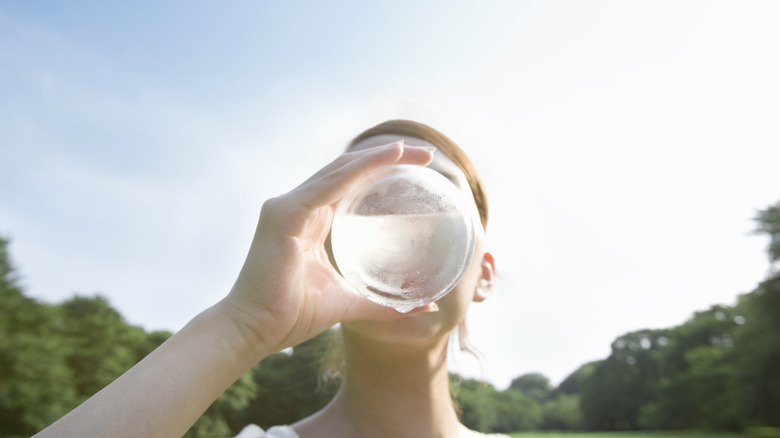Mistakes Everyone Makes With Soda Machines
We're truly living in the age of seltzer. Sparkling water is everywhere, with brands like LaCroix and Liquid Death leading the charge. So, it only stands to reason that soda makers are popular. These appliances make sparkling water that you can augment however you want to create all kinds of tasty drinks. Unfortunately, there are some common mistakes that just about everyone makes with soda machines.
Whether you choose to add syrups to your sparkling water to make soda, add other flavorings for unsweetened flavored water, make hard seltzers, or drink it plain, there are common issues that many people run into. Using a soda machine should be a fun way to hydrate, letting you experiment with different drink types and make your own creations. So, there's no point in stressing over the details, but you should know what to do and what not to do to avoid some common pitfalls. Armed with this information, you're more likely to make the most out of your seltzer maker and keep using it for years to come, rather than relegating it to the back of a kitchen cabinet. So, take note of these common soda machine mistakes and prepare to enter your sparkling water era.
Thinking there's only one level of carbonation
A common mistake people make when using soda makers is assuming that there is only one level of carbonation. In fact, most soda machines make it easy to adjust the carbonation level, and this is one of their key selling points — you can have your sparkling water as mildly sparkling or as robustly effervescent as you like.
Here's the deal — you've just bought a shiny new soda machine and you're eager to experiment. You fill up the bottle with water, attach it to the machine, and give it a good push of carbon dioxide to carbonate your drink. The result? A moderately fizzy beverage that's reminiscent of store-bought sodas. Satisfied with your creation, you start offering it to guests and family members, thinking you've now mastered the art of homemade soda.
But that isn't the end of the story. Soda makers usually offer the ability to adjust the level of carbonation; the secret lies in the carbonation control feature, which lets users control the amount of carbon dioxide injected into their water. Exactly how you do this varies between models. For instance, most SodaStreams have a single button that you press three times for light carbonation, five times for a moderate sparkle, or seven times for extra-fizzy. So, take a look at your instruction manual and get ready to cater the fizz to your tastes.
Not locking the bottle into place
When getting caught up in the excitement of fizz and flavor that sparkling water makers bring, a common mistake is forgetting to securely lock the bottle into place. It might seem like a simple thing, but it's also easy to overlook, and the results can be frustrating.
Here's how it could go down: You've just bought a brand-new soda maker and you can't wait to try it out. You carefully read the instructions, fill the provided bottle with water, and attach it to the soda maker. You press the carbonation button or lever, expecting the magic of carbonation to happen. But what greets you is a spray of water jetting out of the bottle or leaking all over the counter.
What many users don't realize is that soda makers usually have a safety mechanism designed to prevent the bottle from coming loose while the machine does its thing. When it isn't fully locked in place, disaster can strike, and water can spray everywhere. However, it isn't always that dramatic, sometimes you're just left with a disappointingly flat beverage because some of the carbon dioxide didn't make it into your water.
To avoid spills or flat soda, always take the extra moment to check that the bottle is securely locked into place. Most soda machines have a clear indication or click sound when the bottle is correctly attached.
Filling the bottle past the fill line
With a soda machine, there's definitely more than one way to spray water all over your kitchen. For one, you could fill your bottle past the maximum fill line.
You see, all soda maker bottles have a maximum fill line. Filling the bottle past the designated fill line is not recommended due to safety concerns and the potential to make an awful mess.
Soda makers work by injecting carbon dioxide gas into water, creating carbonated water. When you exceed the fill line, there's less space in the bottle for the gas to dissolve properly. As a result, pressure can build up inside the bottle, making it more prone to leakage, bursts, or even explosions. The fill line is not to be messed around with, clearly.
The increased pressure from overfilling can make the bottle unpredictable and hazardous. In extreme cases, the bottle could rupture, potentially injuring you or damaging things in your kitchen. It isn't common for this to happen, but it's still a real risk.
Filling the bottle beyond the recommended level also increases the chances of spillage and can cause water to spray or leak out when you hit the carbonation button. If that happens, you have to clean it up, which isn't what you were asking for when you just wanted a nice fizzy drink.
Not knowing what your can and can not carbonate
You're probably bubbling with excitement to whip up all sorts of carbonated concoctions. But before you let your fizz fantasies run wild, you need to know what you can and can't carbonate in your nifty little gadget.
Let's start with the basics — water is the prime candidate for carbonation in your soda maker. You can drink that water plain or transform it after you've added a touch of bite. There are all kinds of syrups for making soda, or you can infuse it with natural ingredients such as fruit and herbs.
Technically speaking, most soda makers can carbonate more than just water. But just because you can doesn't necessarily mean that you should. In the case of SodaStream seltzer makers, your warranty is invalidated if you fizz up anything other than water. The people at CNET did some vital reporting and discovered that they could safely and effectively carbonate a range of drinks, including wine, orange juice, tea, and coffee. However, liquids other than water can junk up the nozzle, so make sure to clean it thoroughly after use, and keep that aforementioned warranty issue in mind.
If you want to fizz up more than just water without breaking any rules, there are some soda makers on the market that carbonate any liquid. The Drinkmate is perhaps the most popular.
Only using soda syrups
One use for soda machines is making your own soda at home, and you can buy a variety of soda syrups to add to water after you've fizzed it up. However, there's way more to these machines than just making sweet sodas. If you only ever use soda syrups, then you're missing out. There are plenty of alternatives to making delicious flavored water.
Adding fresh fruits is a fantastic way to infuse your sparkling water with natural flavors. Berries, citrus fruits, and tropical fruits work especially well. Simply muddle the fruits in the bottom of your glass or use fruit slices as a garnish.
Fresh herbs can take your sparkling water to the next level. Mint is an especially popular choice, as it's more associated with sweet foods and drinks than savory dishes. However, you can get more creative — basil, rosemary, and thyme also work well in drinks. Crush or tear the herbs slightly before adding them to your sparkling water to release their aromatic oils.
Cucumber is incredibly refreshing and makes for a crisp and cool drink. Slice it thinly and add it to your sparkling water for a delightfully delicate flavor or add fresh ginger for a zesty kick. Thinly slice or grate ginger and let it steep in your sparkling water for a punchy taste. Citrus zest is also a nice addition to sparkling water and pairs well with a range of other flavors.
Never using soda syrups
While it's certainly a mistake to only use soda syrups in your sparkling water, it's also a mistake to never experiment with them. You can find soda syrups that are designed to recreate your favorite drinks, from name-brand Pepsi to Mountain Dew knockoffs and generic root beer. Most are available in sugary versions and diet versions made with artificial sweeteners.
However, if you're not a huge soda person, there are some more left-field options available. After all, there's a big difference between a basic soda and an artisan or homemade soda. You'll find some small companies making gourmet soda syrups with more unusual flavors and flavor combinations, such as elderflower or mint and lime.
Then, you have the option to make your own soda syrups. If you do this, you can let your imagination go wild and come up with any flavor profile you desire. Ever wanted to try a strawberry and basil soda or an orange and rosemary soda? Make your own syrups and you can have any flavor that tickles your fancy.
Choosing the wrong carbon dioxide cylinder
Soda makers have revolutionized the way we enjoy carbonated drinks at home. But amidst the excitement of creating fizzy delights, there's one common mistake that many users stumble on — selecting the wrong carbon dioxide cylinder. You might think "carbon dioxide is carbon dioxide," but not all cylinders are the same and you need to make sure you get the right one for your machine.
Size matters when choosing a carbon dioxide cylinder. Soda makers typically have specific cylinder compatibility, and opting for the wrong size can lead to a frustrating experience. If the cylinder is too large or too small for your soda maker, it simply won't fit.
The thread on the neck of the carbon dioxide cylinder must match the thread on your soda maker. There are different types of threads used by various manufacturers and using an incompatible cylinder might result in leaks or it may not fit. This varies between soda machine brands and models, so always read the manual or check the manufacturer's website for recommended carbon dioxide cylinder specifications. It's not always the case of just choosing the same brand of cylinder, either. For instance, some SodaStreams use screw-in cylinders while others use quick-connect cylinders.
What's more, not all carbon dioxide cylinders are of the same quality, and some may contain impurities that affect the taste and safety of your beverages. Always ensure that the carbon dioxide cylinder you choose is of food-grade quality, meeting safety standards for use with consumable products.
Not cleaning your seltzer maker
Many people believe that there's no need to clean their soda machine, especially if it only carbonates water. But this is a mistake that needs rectifying. It's important to clean this handy gadget every once in a while to keep it hygienic and to keep your drinks tasting fresh.
Imagine you take a sip of your freshly carbonated creation, and instead of the crisp, clean taste you expect, you're hit with a funky aftertaste. That's where regular cleaning swoops in to save the day. By giving your soda maker a good scrubbing, you banish those lingering flavors and say hello to pure, refreshing goodness with every sip.
Are your bubbles acting up? Residue buildup in your soda maker's nooks and crannies can mess with the carbonation, leaving you with lackluster fizz or inconsistent bubbles; this is another problem you can solve with regular cleaning.
Then there's the issue of hygiene. No one invited bacteria and germs to the party, but if you don't clean your machine, they'll RSVP and bring along their friends, too. Cleaning can also help your soda maker last longer and let us not forget that a sparkling appliance simply looks better out on your countertop.
We get it: Nobody wants to add an extra cleaning task to their to-do list, but it's essential, and it won't take as long as you probably think.
Putting bottles in the dishwasher
We love our dishwashers. These little home robots take some of the drudge work out of clearing up. However, in most cases, it's a mistake to put soda machine bottles in the dishwasher. It's a bummer having one extra thing to wash in the sink, but there's a good reason for it.
Most soda maker bottles are made of plastic or other materials that can't stand up to the high temperatures and harsh detergents used in dishwashers. The heat and chemicals can cause the plastic to warp, crack, or deteriorate, damaging the bottle. This damage might result in leaks or difficulty in securely fastening the bottle to the soda maker, affecting its carbonation process and potentially causing messy spills.
Dishwashers are designed to clean dishes thoroughly, but they may not be gentle enough for soda maker bottles. The aggressive cleaning action could damage the bottle's surface, affecting its ability to retain carbonation properly.
That's before we get to the issue of potential odors and flavors. The high heat and humidity inside the dishwasher may cause residue, flavors, or odors from other dishes to transfer onto the soda maker bottle. This can lead to an unpleasant taste or smell in your carbonated beverages.
However, there are some exceptions. If your soda maker explicitly states that its bottles are dishwasher-safe, it's fine to clean them in this way.
Not knowing how to exchange a carbon dioxide cylinder
You've been living it up, enjoying bubbles in all your drinks when — oh no! — you've run out of gas in your carbon dioxide cylinder. Now, one of the annoying things about soda machines is that you have to pay for new cylinders when your old one runs out. It's annoying, but it's just part and parcel of the seltzer maker experience.
However, one mistake many people make is not knowing that they can exchange their old cylinders when they buy a new one and get a discount on the new cylinder. This brings down the cost significantly and spares you from having to figure out how to dispose of old cylinders.
So, how do you do this? Well, this depends on the make of your soda machine and where you buy the new cylinder. If you have a SodaStream, you can do this either online or in a range of stores. But there are other rules for different soda machine brands. For instance, Drinkmate offers an online carbon dioxide exchange, where you send cylinders back to the company and get a coupon for money off new ones. The great thing is that it accepts other brands of carbon dioxide cylinders, not just its own.
Using water that's too warm
One thing that you might not realize when using a soda machine is that it's best to use chilled water, not room temperature water.
What's the point of following this seemingly picky rule? Well, cold water can dissolve more carbon dioxide than warm water or room temperature water. When you pressurize cold water with carbon dioxide in a soda maker, it absorbs the gas more effectively, which gives you better carbonation and fizziness in the final drink. Cold water also helps to preserve the flavor of the drink. When water is cold, it tends to hold onto dissolved gas, like carbon dioxide, more effectively. This means that the carbonation will stay in the drink for a longer time, and you'll experience the full carbonated taste with each sip.
Plus, there's an added bonus. When you carbonate cold water, the resulting drink is already chilled, so you might not need to use ice to cool it down — or if you do use ice, it won't melt right away and dilute your drink. So, using chilled water in your seltzer machine is ideal. You can either keep a spare carbonation bottle filled with water and ready to go in the fridge or keep a jug of water in the fridge and fill the bottle from there.
Not having a smaller bottle
There's a common problem that many soda maker users run into. They carbonate a full bottle of water only to find that they don't manage to use it all up before it goes flat. That's why it's nice to have the option of using a smaller bottle as well as a larger one. Some soda machines come with both a large and a small bottle. Alternatively, you may be able to buy a more compact bottle separately.
Another benefit of having a smaller bottle is that it's more portable, making it easier for you to enjoy your effervescent creations on the go. It also means that you can prepare smaller batches to try out new combinations or unique soda flavors without committing to a large volume.
Of course, in some cases, if you want less water, you could just fill up your bottle below the max fill line. But, whether or not this works well depends on what sparkling water maker you have. In some cases, there's a nozzle that needs to be submerged in water for it to effectively carbonate it.
